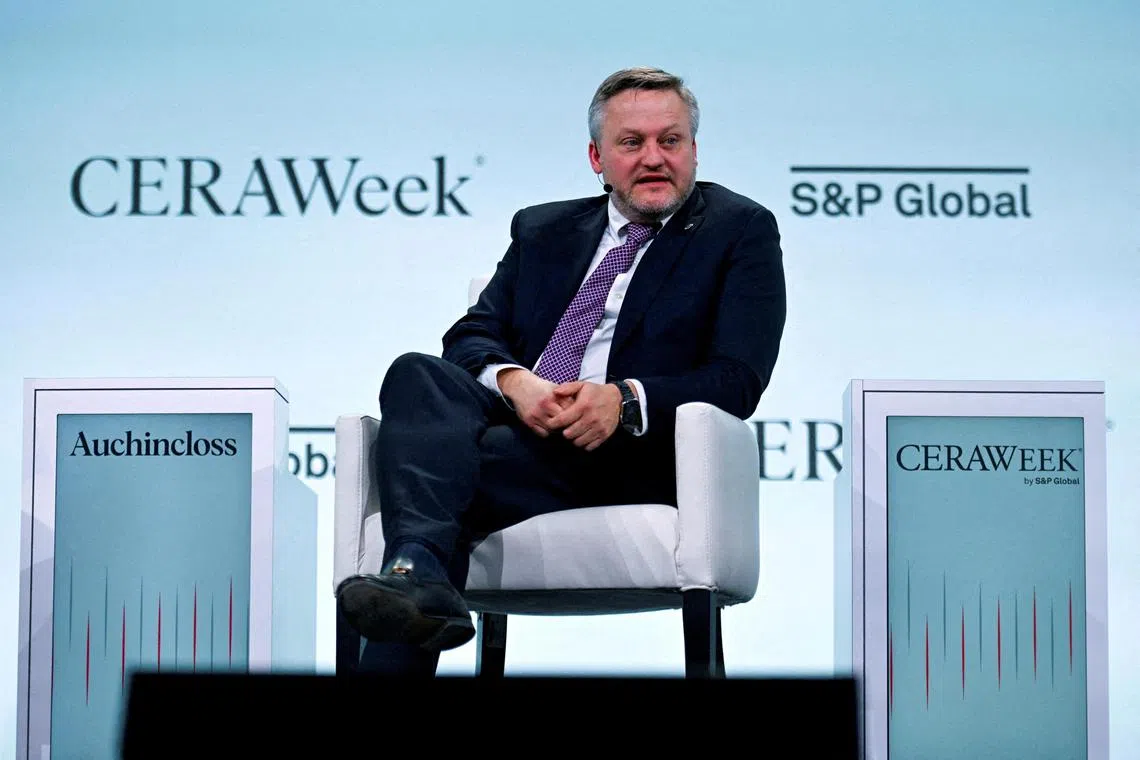BP cuts renewable investment and boosts oil and gas in strategy shift
Sign up now: Get ST's newsletters delivered to your inbox

BP has faced a difficult trading year and is under pressure from investors to boost its share price.
PHOTO: EPA-EFE
Follow topic:
LONDON – BP slashed planned investment in renewable energy and said on Feb 26 that it would increase annual oil and gas spending to US$10 billion (S$13.4 billion), in a major strategy shift aimed at boosting earnings and investor confidence.
The oil major, which has underperformed peers such as Shell and Exxon, has come under increasing pressure to change strategy after news US activist investor Elliott Investment Management has built a 5 per cent stake in the company.
BP cut planned annual investment in renewable energy businesses by more than US$5 billion, from its previous forecast, to between US$1.5 billion and US$2 billion a year. It now aims to grow oil and gas production to between 2.3 million and 2.5 million barrels of oil equivalent per day (boepd) in 2030. It pumped 2.36 million boepd in 2024.
“It is a radical shift,” chief executive Murray Auchincloss told Reuters in a phone interview after the announcements during the company’s investor day. It is the latest big energy company to change its position in response to the need to lower carbon emissions and curb climate change, returning the focus to oil and gas.
Under Mr Auchincloss’ predecessor Bernard Looney, BP pledged in 2020 to cut oil and gas output by 40 per cent while rapidly growing renewables by 2030. It lowered that target to 25 per cent in 2023.
BP also revised its approach to so-called Scope 3 emissions by removing its previous target of a 20 per cent to 30 per cent absolute reduction between 2019 and 2030. The emissions account for greenhouse gases, such as carbon dioxide, released in the atmosphere from a company’s supply chain and the consumption of its products by customers. It now aims to cut the carbon intensity of its energy products by up to 10 per cent over the same period.
Mr Auchincloss said the transition to renewable energy has been slower than BP initially expected following the war in Ukraine, the Covid-19 pandemic, volatile energy markets and changing attitudes towards renewable energy in some countries.
“What that meant is hydrocarbon demand continues to be very, very strong, stronger than we would have envisioned five years ago, and the transition has not proceeded at the pace we would have thought,” he said.
“We will be very selective in our investment in the transition, including through innovative capital-light platforms. This is a reset BP, with an unwavering focus on growing long-term shareholder value.”
Expenditure and cost cuts
“Three big things we have done: reducing capex (capital expenditure), reducing costs, material divestment with an outcome of growing cashflow and returns,” Mr Auchincloss said.
BP aims to spend between US$13 billion and US$15 billion annually through 2027, trimming US$1 billion to US$3 billion from 2024 levels, with 2025 capex expected to be around US$15 billion.

Chief executive Murray Auchincloss said BP was reallocating capital expenditure to its highest-returning businesses to drive growth.
PHOTO: REUTERS
It plans to raise its dividend by at least 4 per cent per share annually and expects first-quarter share buybacks of US$750 million to US$1 billion, a downward revision from its previous US$1.75 billion forecast.
BP shares closed 1.37 per cent lower at 430.9 pence, slipping below the levels seen before reports emerged early in February that Elliott had built a significant stake in the company.
“The updated guidance directionally all looks in line with expectations, however we think the capex cut was less material than many investors were suggesting to us, while in the near term, shareholder returns for BP are now lower than peers,” RBC Capital Markets analyst Biraj Borkhataria said.
“To us, much of the release looks to be BP making the right calls for the long term, but it may not please investors today,” Mr Borkhataria added.
BP also said it was reviewing its lubricants business, Castrol, and targeting US$20 billion in divestments by 2027.
It plans to bring in a 50 per cent partner for its solar business, Lightsource BP, with a sale process expected in the next few months. REUTERS

